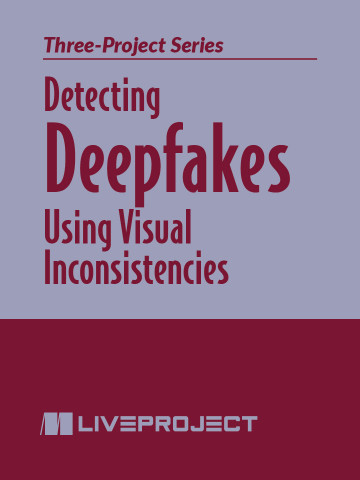- prerequisites
- intermediate Python • beginner scikit-learn and scikit-image • basics of OpenCV
- skills learned
- face detection • SVM classification • image processing • building a binary classification system
pro $24.99 per month
- access to all Manning books, MEAPs, liveVideos, liveProjects, and audiobooks!
- choose one free eBook per month to keep
- exclusive 50% discount on all purchases
lite $19.99 per month
- access to all Manning books, including MEAPs!
team
5, 10 or 20 seats+ for your team - learn more

In this series of liveProjects, you’ll step into the role of a forensics consultant. You’re investigating a ring of cyber criminals who are blackmailing prominent social media personalities with scandalous “deepfake” videos. These videos use a deep learning model to splice a victim’s face onto an actor, creating highly realistic content that can be indistinguishable from the real thing. Your boss wants you to develop a method to efficiently detect these deepfakes from a huge data set of online videos. The method needs to be fast, and also run without needing GPU resources, which are in short supply. Each project in this series covers a different aspect of developing this deepfake detecting solution, with essential computer vision and machine learning skills you can easily transfer to other tasks.
here's what's included




team
- five seats for your team
- access to all Manning books, MEAPs, liveVideos, liveProjects, and audiobooks!
- choose another free product every time you renew
- choose twelve free products per year
- exclusive 50% discount on all purchases
-
![]() Detecting Deepfakes Using Visual Inconsistencies project for free
Detecting Deepfakes Using Visual Inconsistencies project for free
Prerequisites
This liveProject is for developers who know Python, the basics of machine learning, and the basics of processing image data. To begin this liveProject, you will need to be familiar with the following:
TOOLS
- Basics of Jupyter Notebook
- Basics of OpenCV
- Basics of scikit-learn
- Basics of Matplotlib
- Basics of scikit-image
- Basic signal and image processing
- Basic image feature and metrics computation
- Basic understanding of how classification systems are evaluated
- Basic understanding of classification with linear support vector machine
 features
features
- Self-paced
- You choose the schedule and decide how much time to invest as you build your project.
- Project roadmap
- Each project is divided into several achievable steps.
- Get Help
- While within the liveProject platform, get help from fellow participants and even more help with paid sessions with our expert mentors.
- Compare with others
- For each step, compare your deliverable to the solutions by the author and other participants.
- book resources
- Get full access to select books for 90 days. Permanent access to excerpts from Manning products are also included, as well as references to other resources.

 Detecting Deepfakes Using Visual Inconsistencies project for free
Detecting Deepfakes Using Visual Inconsistencies project for free